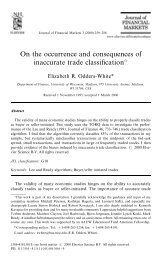A generic framework for Arabic to English machine ... - Acsu Buffalo
A generic framework for Arabic to English machine ... - Acsu Buffalo
A generic framework for Arabic to English machine ... - Acsu Buffalo
Create successful ePaper yourself
Turn your PDF publications into a flip-book with our unique Google optimized e-Paper software.
4.2.5 Syntactic analysis (Parsing)<br />
4.3. BASIC MACHINE TRANSLATION STRATEGIES<br />
Syntactic analysis, or parsing, is a major component in a rule-based MT system. It is the<br />
process by which a sentence is dissected or analysed in<strong>to</strong> constituent parts, <strong>to</strong> determine<br />
grammatical structure. One of the key challenges in analysis is dealing with ambiguity.<br />
One approach is what is called depth-first parsing, in which each possible solution is pur-<br />
sued <strong>to</strong> its conclusion. Each time a solution is found <strong>to</strong> be wrong, the system backtracks<br />
and takes another route until it eventually finds the correct categorisation of a word. In<br />
breadth-first parsing, alternatives are evaluated in parallel, until each alternative is found<br />
<strong>to</strong> be wrong except the right one.<br />
4.3 Basic <strong>machine</strong> translation strategies<br />
Traditionally three different approaches <strong>to</strong> MT have been used: direct translation, inter-<br />
lingua translation and transfer based translation. A few new approaches have also been<br />
established. In this section we will discuss basic strategies of MT systems.<br />
4.3.1 Multilingual versus bilingual systems<br />
Bilingual systems translate between a single pair of languages; multilingual systems<br />
translate between more than two languages. Bilingual systems are uni-directional or<br />
bi-directional, they may be designed <strong>to</strong> translate from one language <strong>to</strong> another in one<br />
direction only, or they are able <strong>to</strong> translate from both members of a language pair. As a<br />
further modification we may differentiate between reversible bilingual systems and non-<br />
reversible systems. In a reversible bilingual system the process involved in the analysis<br />
of a language can be inverted without change <strong>for</strong> the generation of output in the same<br />
language.<br />
50
















